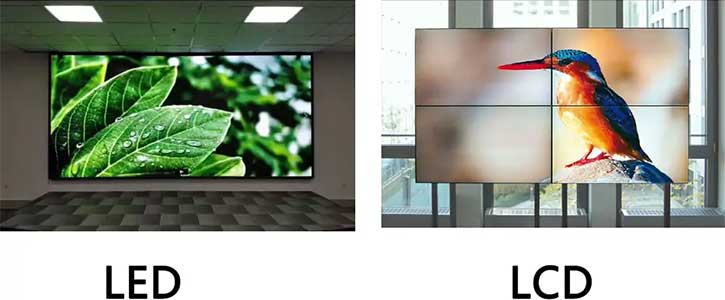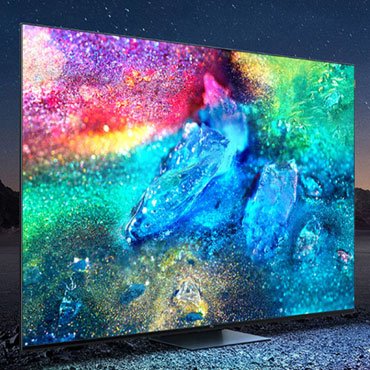We have previously introduced the comparison between LCD and LED in detail. You can click on the title below to read:
Today I want to talk about the difference between LED and LCD from other perspectives.
Display effect
LED emits light autonomously and has the advantages of high brightness, high contrast, high color saturation, and high definition. After being spliced into an LED display, the displayed picture will be more vivid and realistic.
LCD is made of liquid crystal material, and this material itself cannot emit light. It needs to use cold cathode fluorescent lamps or LEDs as backlights to display images.
Due to the light loss in the refraction process, compared to LED, the final display screen of LCD will be weaker than that of LED display screen.
Energy consumption
LEDs consume less energy than LCDs. Because LED itself is a low-power light source, it can effectively reduce power consumption and heat generation.
However, the LCD needs to supply power to the liquid crystal material and the backlight at the same time, otherwise it cannot display the picture, so the energy consumption will be slightly higher.
Some people may be curious about whether we can perceive the level of energy consumption. In fact, there is a simple way, and that is to find a reference object. For example, the light bulbs we use every day are a form of light that consumes very high energy.
Because the bulb needs to slowly heat the filament to emit light when it is powered on, we can find that it is very hot when we touch the bulb. On the other hand, the temperature of LED and LCD is much milder, so by touching the temperature of the object, we can simply evaluate the energy loss of an object.

Size
Due to the different manufacturing processes of LCD and LED displays, the sizes of the two are quite different. LCD needs to be processed and formed before leaving the factory. For example, if you need a 55-inch LCD monitor, you need to make it 55 inches. If you need a 110-inch LCD monitor, you need to make it 110 inches.
If you want to splice it later, there will be a black gap that affects the viewing effect. The LED display screen is spliced through LED modules, or it can also be spliced through LED boxes. You can make it as big as you need. The resulting screen will look like No gaps.
Thickness
Unlike LED, LCD needs to first embed the LED lamp beads on the LED module, and then embed the LED module on the LED box. Instead, the liquid crystal material is directly placed in the laminated glass.
Therefore, the thickness of LCD is much smaller than that of LED. This property makes LCD always have an unshakable position in small-size displays.
Weight
The LED display must splice multiple LED boxes together for display. The weight of an LED box and LED module is almost the combined weight of eight LCDs, so being lighter is also one of the advantages of LCD.
Viewing angle
The viewing angles of LCD monitors vary depending on the selected panel. Common LCD panels include VA panels and IPS panels.
VA panel
The advantage of a VA (vertical alignment) panel is that it has a relatively high contrast ratio, the black it displays is purer, and its text display is particularly clear.
However, VA panels have more disadvantages than advantages. For example, the viewing angle is small, and if it is slightly deviated, the picture will have a more obvious color cast. When playing games, video editing and other operations, the slow response speed will also cause the screen to smear.
IPS panel
The advantages of IPS (In-Plane Switching) panels are high viewing angle, fast response speed, accurate color reproduction, and the price is similar to that of VA panel LCDs.
However, the disadvantage is that the black purity is slightly worse than that of VA panels. Therefore, it is necessary to rely on the compensation of optical films to achieve better black.
Because LED can directly illuminate the screen surface without filtering the liquid crystal layer, it can achieve a wider viewing angle, so the viewing angle of the LED display is better than that of the LCD.
Price
LED displays are much more expensive than LCDs. This is because LED displays use advanced technology and higher quality materials, resulting in higher performance and longer service life.
LCDs, on the other hand, are simple to operate, just plug them in and turn on the switch. However, LED displays require manual splicing of modules and cabinets. If it is a larger project, you also need to consider a welded steel structure to bear the weight of the LED display. Therefore, the labor cost is very expensive, which will undoubtedly cause the price of the LED display to be higher than LCD is higher.
Application scenarios
LED displays are suitable for large-scale display scenes, such as outdoor LED displays on high-rise buildings, LED background walls on large stages, etc., while LCDs are more suitable for small display scenes such as computer monitors and flat-panel displays
Summarize
LED display has strong advantages in waterproofing, energy consumption, display effect, etc., while LCD has irreplaceable advantages in thickness, weight, price, etc.
Both parties have their own limitations, and customers can choose the display device that suits them based on their actual needs.




